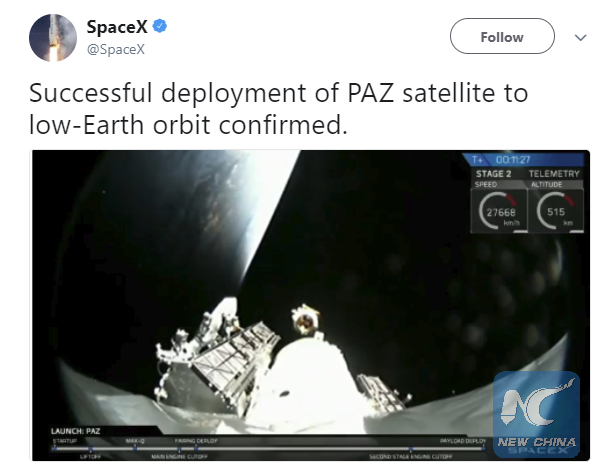
SpaceX's tweet on the PAZ mission.
LOS ANGELES, Feb. 22 (Xinhua) -- U.S. private flight company SpaceX on Thursday launched its first two test satellites for its global broadband internet-in-space project.
The company plans eventually to create a giant constellation of about 12,000 small satellites delivering broadband access around the world.
A used Falcon 9 rocket blasted off at 6:17 a.m. local time (1417 GMT) from Space Launch Complex 4E at California's Vandenberg Air Force Base, carrying

The SpaceX Falcon 9 rocket carrying a PAZ Earth Observation satellite is launched from Vandenberg Air Force Base (AFB) as seen from Ventura, California, U.S., Feb. 22, 2018. (Xinhua/REUTERS)
The launch's primary mission is to deliver PAZ into orbit for the Spain-based company Hisdesat. The satellite has been deployed approximately 11 minutes after launch.
"Successful deployment of PAZ satellite to low-Earth orbit confirmed," the California-based company tweeted.
According to the mission description, equipped with an advanced radar instrument, PAZ will cover the entire globe in 24 hours, serving both commercial and government needs. Designed for a mission life of five and a half years, PAZ will orbit Earth 15 times per day, providing an internet coverage for an area of over 300,000 square km from an altitude of 514 km and at a velocity of 7 km per second.

File Photo: SpaceX Falcon 9 lifts off from Space Launch Complex 4E at Vandenberg Air Force Base in California, the U.S., Jan. 14, 2017. (Xinhua)
However, PAZ was not riding alone on the recycled Falcon 9.
Quietly on board were two additional experimental broadband satellites, Microsat-2a and Microsat-2b, a big first step in SpaceX's long-term plans to create satellite internet over the next decade.
Falcon 9's first stage for the PAZ mission previously supported the FORMOSAT-5 mission from SLC-4E in August 2017. SpaceX did not attempt to recover Falcon 9's first stage after Thursday's launch.
SpaceX called off an attempted launch of its Falcon 9 rocket Wednesday morning due to strong high-altitude winds. The launch, initially targeted for Saturday, Feb. 17, was first delayed 24 hours due to final checks, and then subsequently to no earlier than Feb. 21 because of additional checks and mission-related requirements.

